A Comparative Study of Optimal Energy Management Strategies for Energy Storage with Stochastic Loads
Abstract
1. Introduction
- Conventional or traditional controllers such as set-point controller and proportional integral (PI): this type of storage controllers is limited to a specific target or reference value. These controllers generate control decisions based on a determined target or reference value such as current, energy level and voltage. The reference value is determined based on an a priori network data together with domain-expert knowledge. Due to the simplicity of these conventional controllers, they have been widely used in RTG crane systems with storage devices for reducing gas emissions and peak demand [5,6,7,8]. Furthermore, the set-point controller is also used as a standard benchmark control system for an ESS in LV applications [9] and RTG cranes [2]. However, these controllers are principally limited for controlling volatile and nonsmooth demands, solving complex energy problems and targeting the energy savings and peak reduction over long periods of time such as an entire day. In addition, the set-point and PI controllers are sensitive to the set-point and use no knowledge of the potential future demand.
- Optimal controllers: this energy control category can be further divided into optimal controllers that use, or do not use, forecast of the demand. Both controllers in this category work to find the optimal (the best) ESS operation plan based on the parameters and limitations of the electrical network and storage device [10,11]. However, the optimal controllers are more complex, with higher computational costs, compared to the conventional controllers [11,12]. While many papers have discussed and investigated optimal energy control strategies for LV demands such as residential customers, there is limited literature on using these strategies for reducing peak demand or energy costs for RTG crane networks. In 2017, Pena-Bello et al., presented an optimisation operation algorithm for a battery storage system for grid-connected housing with a PV system [13]. The model in [13] assumed a perfect forecast for the residential load and PV generation, which is unrealistic in practice. The research does not consider the impact of forecast error or the variability of the PV generation on the operational model and results. The literature [13,14,15] has shown that accurate forecasts are important to optimise the control of an ESS. The literature has introduced the optimal control of ESS with load forecasts as a key feature for improving the peak reduction and the cost savings. However, it has widely focused on developing different planning, operation schedules based on full future knowledge to increase the energy savings by assuming a perfect forecast for the residential load and PV generation [13], which is unrealistic in practice and assumes that the charged energy was fixed and equal to a specific magnitude in [16].
- Firstly, we develop three predictive optimal controllers (MPC, SMPC and optimal controller with fixed forecast) for an ESS within an RTG crane network and compare the corresponding ESS performance. The comparison in this paper investigates the stability and robustness of the proposed controllers by using different forecast models and data sets to test the proposed ESS controllers. This evaluation is significant to understand the impact of forecast errors on the ESS control algorithms and due to the limited literature on developing predictive control algorithms for stochastic load, such as RTG crane demand.
- Secondly, unlike the limited literature [10,11], which do not investigate the complexity and computational cost of the predictive control model, this paper analyses the ESS performance by taking into consideration the main characteristics of the proposed optimal energy controllers. The analysis in this paper aims to introduce an initial assessment of the complexity for a practical implementation of the proposed optimal control systems.
2. RTG Cranes and ESS Models Topology
- Four gantry motors to move the crane around the site.
- Hoist motor to raise container weights of up to 40 tones.
- Two trolley motors to move the hoisting unit across the span of the crane.
3. The Electrified RTG Crane Demand
- Overview of the electrified RTG crane demand;
- Time series analysis.
3.1. Overview of the Electrified RTG Crane Demand
3.2. Time Series Analysis
- Accurate forecasts: the half hourly demand for the next 48-time steps are generated by using the most accurate forecast model with the mean absolute percentage error (MAPE) forecast errors between 8% and 24%, as presented in [3]. This forecast model estimates the number of RTG moves, while assuming the container gross weight is known in advance.
4. Optimal Energy Controllers for RTG Crane Network
- 1
- Optimal energy controller with a fixed load forecast profile: a 24 h-ahead RTG crane demand forecast and electricity price data are fed into the optimal control system. The control model will be updated once every 24 h. As discussed previously, the RTG crane demand profile is volatile and nonsmooth; therefore, developing an optimal controller for an RTG crane network is difficult and challenging [3,10].
- 2
- Model Predictive Controller: the MPC aims to minimise the peak demand and electricity cost by finding the optimal ESS output and using a rolling forecast model to predict the RTG cranes demand. In this control model, the rolling forecasting minimises the impact of forecast error within the day on the ESS performance compared to the previous model with fixed load forecasts. However, in realistic scenarios, the RTG crane demand profile includes a high level of uncertainty. For example, the crane electrical demand is quite variable even when the RTG is lifting the same container gross weight [3,11], and this is mainly due to the human behavioural element (crane operator) during the lifting mode. The container gross weight and numbers of crane moves is used in [3] as input variables for the RTG demand forecast model.
- 3
- Stochastic Model Predictive Controller: the SMPC is designed to handle the diverse and high level of uncertainty of the RTGs demand and the rolling forecast error. The SMPC aims to solve the RTG crane energy optimisation problem under the uncertainty conditions for the forecast demand. In this paper, the future crane demand is modelled as a stochastic variable by generating several future profiles, which is in contrast to the single-point forecast profile used in the MPC model [11].
4.1. Optimal Energy Controller with a Fixed Load Forecast Profile
4.2. Model Predictive Controller
| Algorithm 1: Basic concept of MPC for RTGs network with storage device. |
|
4.3. Stochastic Model Predictive Controller
5. Results and Discussion
- Optimality for peak demand reduction and cost saving: the following section compares and evaluates the potential peak reduction and cost saving results for the predictive controllers (SMPC and MPC) with different levels of forecast accuracy, the set-point controller and the optimal energy controller model with perfect forecast profiles. In order to evaluate the predictive controllers, two future demand profiles from accurate and inaccurate forecast models have been used. This evaluation is significant in understanding the impact of forecast errors on the ESS control algorithms.
- Complexity and computational cost: Section 5.2 presents indicators regarding the complexity of a practical implementation of the predictive optimal controllers.
5.1. Analysis of Energy Storage Control Strategies
Results and Discussion for Optimal ESS Controllers
5.2. Complexity and Computational Cost
SMPC and the Computational Effort
6. Conclusions
Author Contributions
Funding
Acknowledgments
Conflicts of Interest
Abbreviation
| RTG | Rubber tyre gantry |
| MPC | Model predictive control |
| SMP | Stochastic model predictive control |
| ESS | Energy storage system |
| LV | Low voltage |
| MV | Medium voltage |
| PI | Proportional integral |
| PoF | Port of Felixstowe |
| ARIMAX | Autoregressive integrated moving average with explanatory variable |
| SoC | State of charge |
| Power demand (RTG crane) | |
| Power grid at time t | |
| Estimated crane demand at time t | |
| The stored energy in the ESS at time t | |
| Greatest stored energy | |
| Lowest stored energy | |
| Represent the real-time electricity cost at Port of Felixstowe | |
| Costday | The electricity price during daytime (07:00 to 24:00) |
| Costnight | The electricity price during night-time (24:00 to 7:00) |
References
- Mach, J.; Proano, E.; Brown, K. Impacts of electric rubber-tired gantries on green port performance. Res. Transp. Bus. Manag. 2013, 8, 67–76. [Google Scholar]
- Pietrosanti, S.; Holderbaum, W.; Becerra, V. Optimal Power Management Strategy for Energy Storage with Stochastic Loads. Energies 2016, 9, 175. [Google Scholar] [CrossRef]
- Alasali, F.; Haben, S.; Becerra, V.; Holderbaum, W. Day-ahead industrial load forecasting for electric RTG cranes. J. Mod. Power Syst. Clean Energy 2018, 6, 223–234. [Google Scholar] [CrossRef]
- Luque, A.; Alasali, F.; Harrison, I.; Pietrosanti, S.; Mayer, R.; Holderbaum, W.; Becerra, V. Energy reduction on eRTG. In Proceedings of the IEEE 16th International Conference on Environment and Electrical Engineering (EEEIC), Florence, Italy, 7–10 June 2016. [Google Scholar]
- Niu, W.; Huang, X.; Yuan, F.; Schofield, N.; Xu, L.; Chu, J.; Gu, W. Sizing of Energy System of a Hybrid Lithium Battery RTG Crane. IEEE Trans. Power Electron. 2017, 32, 7837–7844. [Google Scholar] [CrossRef]
- Alasali, F.; Luque, A.; Mayer, R.; Holderbaum, W. A Comparative Study of Energy Storage Systems and Active Front Ends for Networks of Two Electrified RTG Cranes. Energies 2019, 12, 1771. [Google Scholar] [CrossRef]
- Zhao, N.; Schofield, N.; Niu, W. Energy Storage System for a Port Crane Hybrid Power-Train. IEEE Trans. Transp. Electrif. 2016, 2, 480–492. [Google Scholar] [CrossRef]
- Alasali, F.; Luque, A.; Becerra, V.; Holderbaum, W. Energy Reduction and Peak Shifting on a Network of Cranes. In Proceedings of the International Conference on Energy, Environment and Economics, Edinburgh, UK, 16–18 August 2016; pp. 137–143. [Google Scholar]
- Rowe, M.; Yunusov, T.; Haben, S.; Holderbaum, W.; Potter, B. The Real-Time Optimisation of DNO Owned Storage Devices on the LV Network for Peak Reduction. Energies 2014, 7, 3537–3560. [Google Scholar] [CrossRef]
- Alasali, F.; Haben, S.; Becerra, V.; Holderbaum, W. Optimal energy management and MPC strategies for electrified RTG cranes with energy storage systems. Energies 2017, 10, 1598. [Google Scholar] [CrossRef]
- Alasali, F.; Haben, S.; Holderbaum, W. Energy management systems for a network of electrified cranes with energy storage. Int. J. Electr. Power Energy Syst. 2019, 106, 210–222. [Google Scholar] [CrossRef]
- Alasali, F.; Haben, S.; Holderbaum, W. Stochastic Optimal Energy Management System for RTG Cranes Network Using Genetic Algorithm and Ensemble Forecasts. J. Energy Storage 2019, 24, 100759. [Google Scholar] [CrossRef]
- Pena-Bello, A.; Burer, M.; Patel, M.; Parra, D. Optimizing PV and grid charging in combined applications to improve the profitability of residential batteries. J. Energy Storage 2017, 13, 58–72. [Google Scholar] [CrossRef]
- Hassan, A.; Cipcigan, L.; Jenkins, N. Optimal battery storage operation for PV syst-ems with tariff incentives. Appl. Energy 2017, 203, 422–441. [Google Scholar] [CrossRef]
- Wu, X.; Hu, X.; Moura, S.; Yin, X.; Pickert, V. Stochastic control of smart home ene-rgy management with plug-in electric vehicle battery energy storage and photovoltaic array. J. Power Sources 2016, 333, 203–212. [Google Scholar] [CrossRef]
- Hellendoorn, H.; Mulder, S.; Schutter, B. Hybrid Control of Container Cranes. IFAC Proc. Vol. 2011, 44, 9697–9702. [Google Scholar] [CrossRef]
- Zhang, Y.; Liu, B.; Zhang, T.; Guo, B. An Intelligent Control Strategy of Battery Energy Storage System for Microgrid Energy Management under Forecast Uncertainties. Int. J. Electrochem. Sci. 2014, 9, 4190–4204. [Google Scholar]
- Alonso, M.; Amaris, H.; Germain, J.; Galan, J. Optimal Charging Scheduling of Electric Vehicles in Smart Grids by Heuristic Algorithms. Energies 2014, 7, 2449–2475. [Google Scholar] [CrossRef]
- Maasoumy, M.; Razmara, M.; Shahbakhti, M.; Vincentelli, A. Handling model uncertainty in model predictive control for energy efficient buildings. Energy Build. 2014, 77, 377–392. [Google Scholar] [CrossRef]
- Wang, X.; Palazoglu, A.; El-Farra, N. Operational optimization and demand response of hybrid renewable energy systems. Appl. Energy 2015, 143, 324–335. [Google Scholar] [CrossRef]
- Holjevac, N.; Capuder, T.; Zhang, N.; Kuzle, I.; Kang, C. Corrective receding horizon scheduling of flexible distributed multi-energy microgrids. Appl. Energy 2017, 207, 176–194. [Google Scholar] [CrossRef]
- Yunusov, T.; Haben, S.; Lee, T.; Ziel, F.; Holderbaum, W.; Potter, B. Evaluating the effectiveness of storage control in reducing peak demand on low voltage feeders. CIRED 2017, 2017, 1–5. [Google Scholar] [CrossRef]
- Ji, Z.; Huang, X.; Xu, C.; Sun, H. Accelerated Model Predictive Control for Electric Vehicle Integrated Microgrid Energy Management: A Hybrid Robust and Stochastic Approach. Energies 2016, 9, 973. [Google Scholar] [CrossRef]
- Oh, S.; Chae, S.; Neely, J.; Baek, J.; Cook, M. Efficient Model Predictive Control Strategies for Resource Management in an Islanded Microgrid. Energies 2017, 10, 1008. [Google Scholar] [CrossRef]
- Song, Z.; Hofmann, H.; Li, J.; Han, X.; Ouyang, M. Optimization for a hybrid energy storage system in electric vehicles using dynamic programing approach. Appl. Energy 2015, 139, 151–162. [Google Scholar] [CrossRef]
- Xie, S.; He, H.; Peng, J. An energy management strategy based on stochastic model predictive control for plug-in hybrid electric buses. Appl. Energy 2017, 196, 279–288. [Google Scholar] [CrossRef]
- Trans-European Transport Network. Report on Port Container Terminals Energy Profile. Green Cranes, 2013. Available online: http://www.greencranes.eu/M2Report.pdf (accessed on 12 January 2020).
- Port of Felixstowe, Hutchisonport Portf Felixstowe. Available online: https://www.portoffelixstowe.co.uk/#/about (accessed on 2 February 2020).
- Zhang, Y.; Zhang, T.; Wang, R.; Liu, Y.; Guo, B. Optimal operation of a smart residential microgrid based on model predictive control by considering uncertainties and storage impacts. Sol. Energy 2015, 122, 1052–1065. [Google Scholar] [CrossRef]
- Halamay, D.; Antonishen, M.; Lajoie, K.; Bostrom, A.; Brekken, T. Improving Wind Farm Dispatchability Using Model Predictive Control for Optimal Operation of Grid-Scale Energy Storage. Energies 2014, 7, 5847–5862. [Google Scholar] [CrossRef]
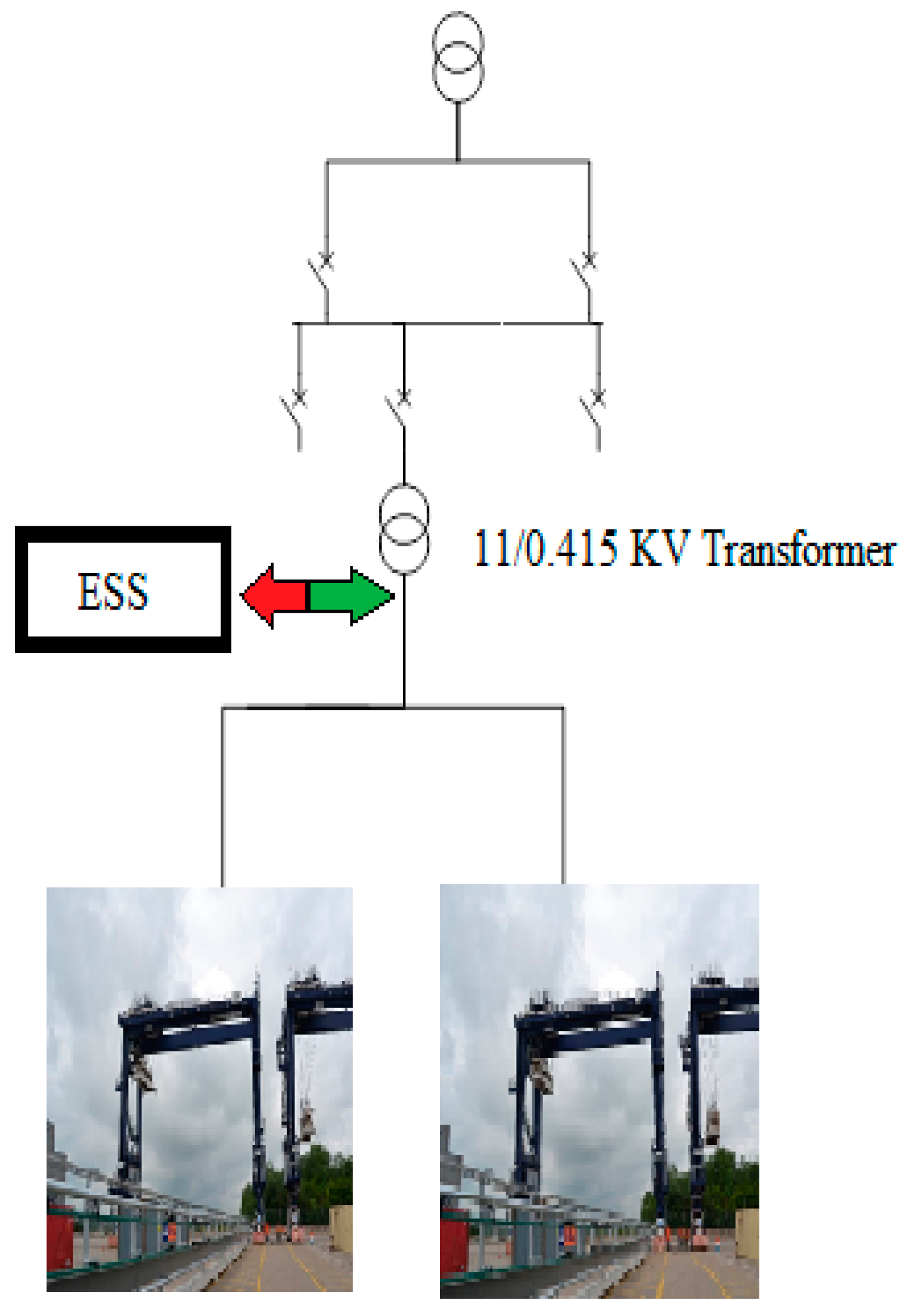
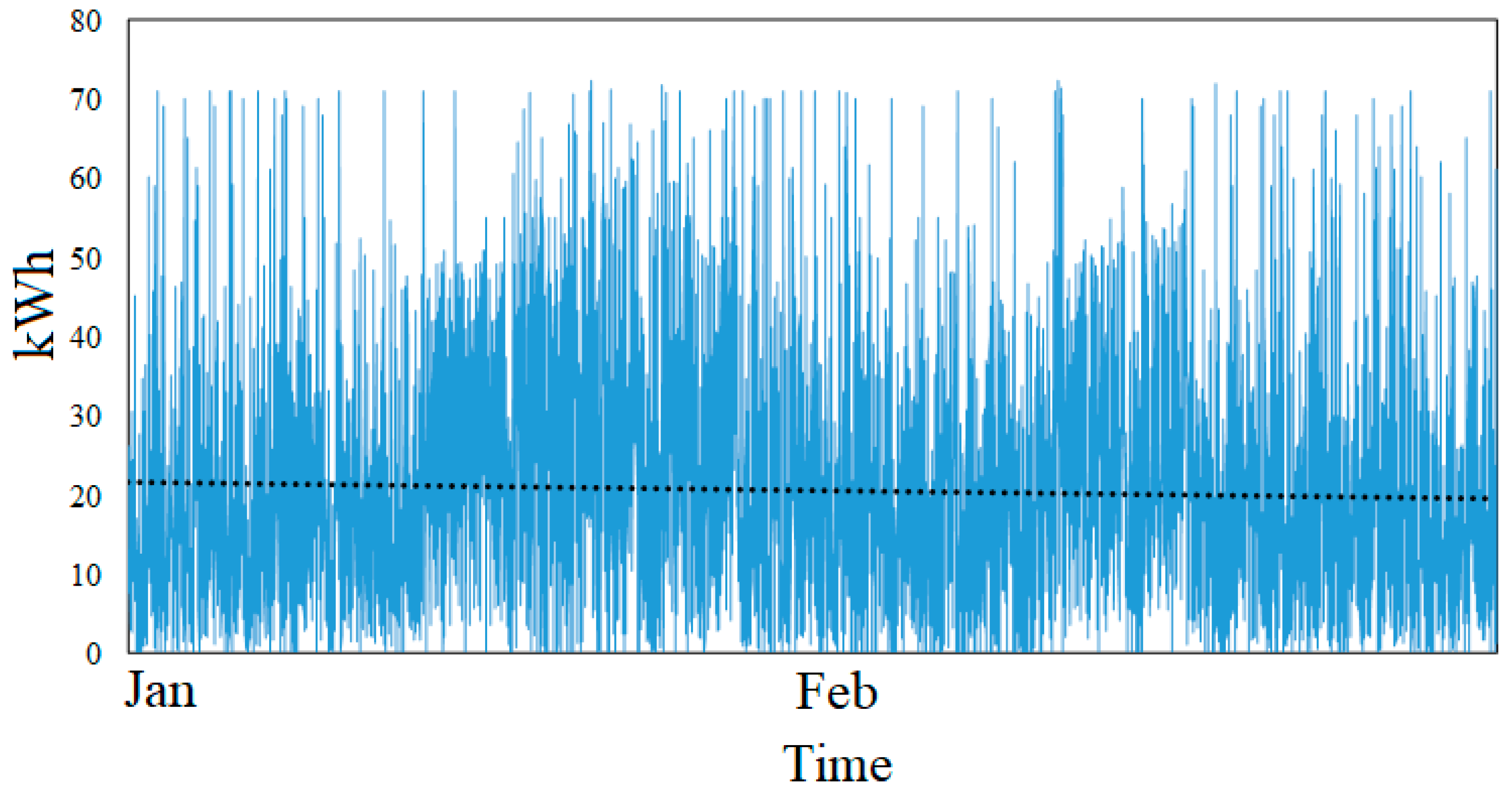

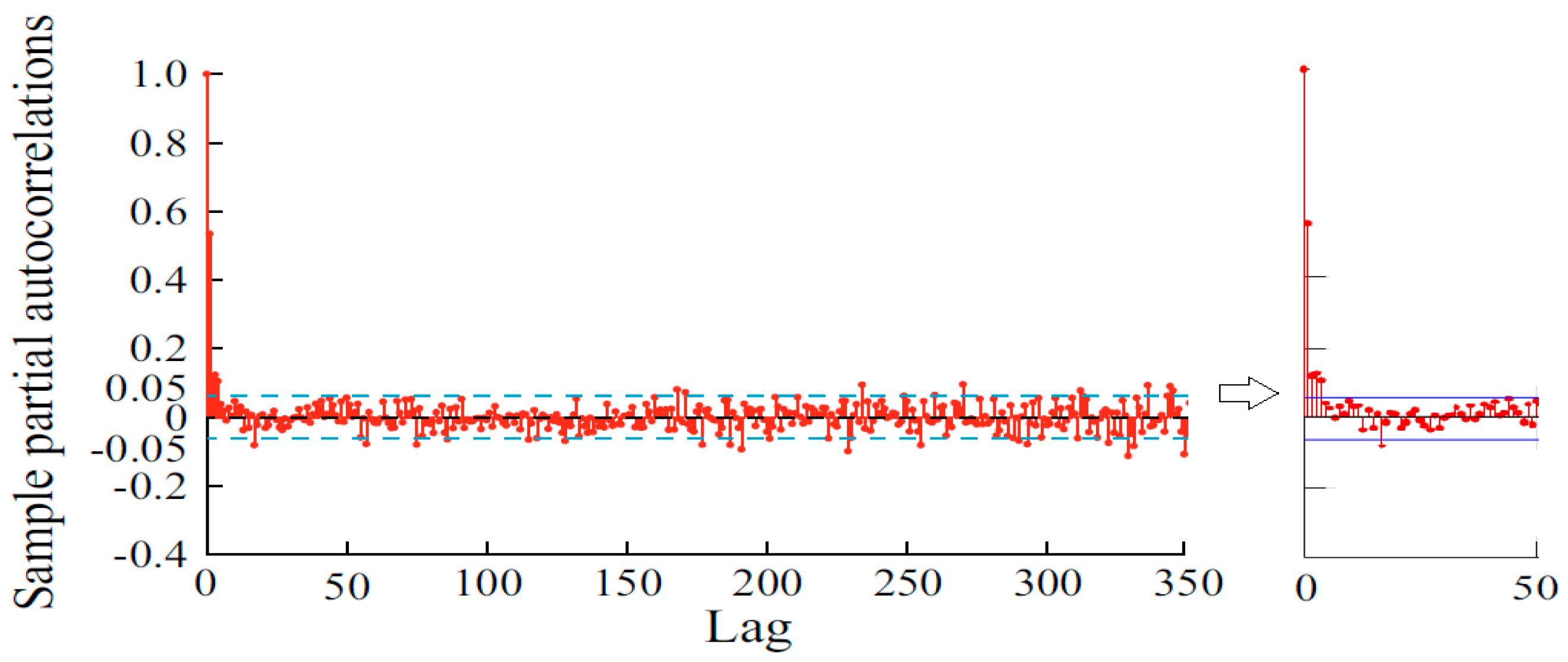
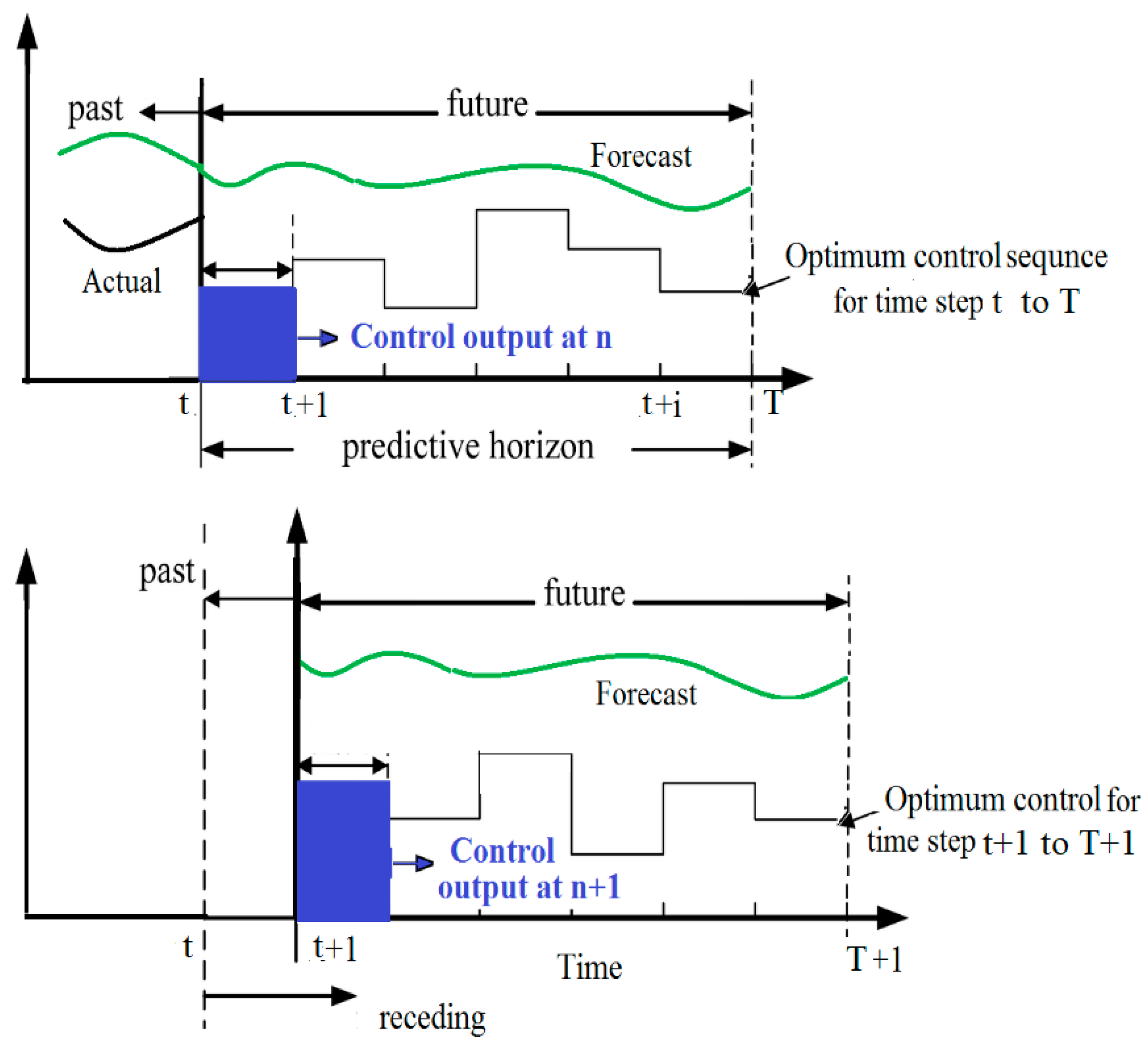

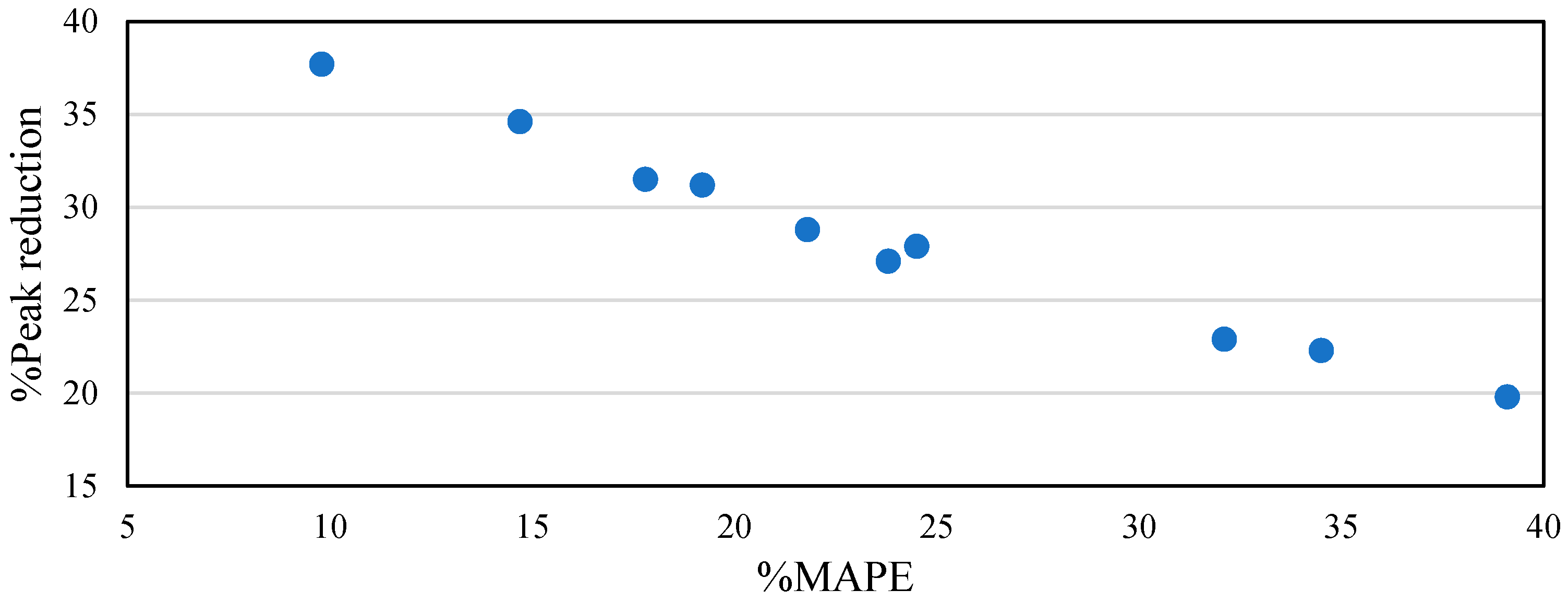
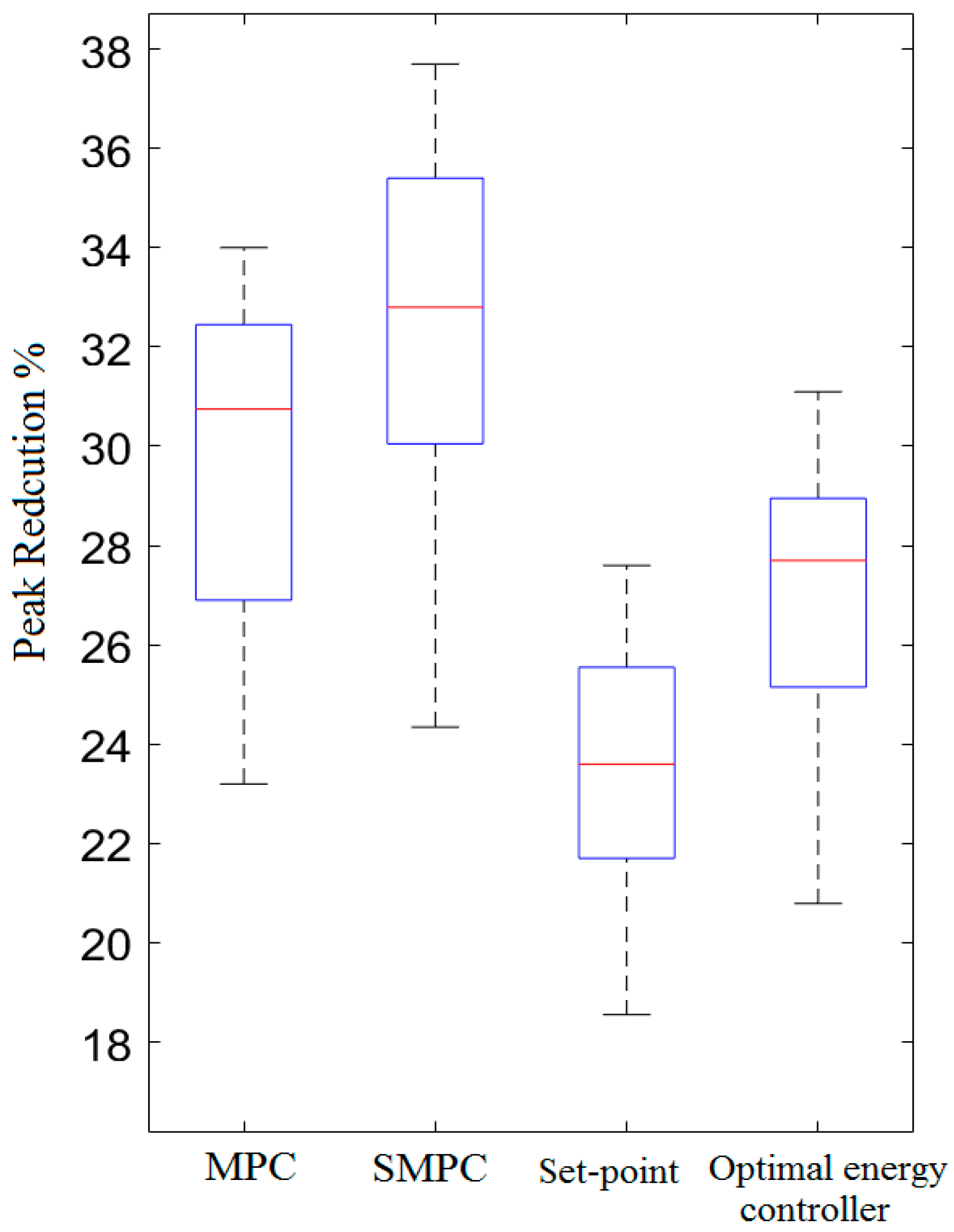
| ESS Control Model | Accurate Forecast Model | MAPE | Peak Reduction% | Inaccurate Forecast Model | MAPE | Peak Reduction% |
|---|---|---|---|---|---|---|
| MPC | ANN (Model B) | 14.2% | 30.2% | ANN (Model A) | 28.3% | 20.2% |
| SMPC | ARIMAX (Model C) | 17.2% | 32.6% | ARIMA (Model D) | 30.1% | 24.2% |
| Controller | Percentage of Cost Saving | ||
|---|---|---|---|
| No Forecast/Perfect Forecast | Accurate | Inaccurate | |
| Set-point | 5.47 | - | - |
| Optimal controller with perfect forecast | 8.01 | - | - |
| MPC | - | 7.26% | 5.88% |
| SMPC | - | 7.98% | 6.96% |
| Number of Forecast Demand Scenarios | Average Simulation Duration (s) | Maximum Simulation Duration (s) |
|---|---|---|
| 5 | 11 | 25 |
| 10 | 21 | 33 |
| 15 | 36 | 49 |
© 2020 by the authors. Licensee MDPI, Basel, Switzerland. This article is an open access article distributed under the terms and conditions of the Creative Commons Attribution (CC BY) license (http://creativecommons.org/licenses/by/4.0/).
Share and Cite
Alasali, F.; Haben, S.; Foudeh, H.; Holderbaum, W. A Comparative Study of Optimal Energy Management Strategies for Energy Storage with Stochastic Loads. Energies 2020, 13, 2596. https://doi.org/10.3390/en13102596
Alasali F, Haben S, Foudeh H, Holderbaum W. A Comparative Study of Optimal Energy Management Strategies for Energy Storage with Stochastic Loads. Energies. 2020; 13(10):2596. https://doi.org/10.3390/en13102596
Chicago/Turabian StyleAlasali, Feras, Stephen Haben, Husam Foudeh, and William Holderbaum. 2020. "A Comparative Study of Optimal Energy Management Strategies for Energy Storage with Stochastic Loads" Energies 13, no. 10: 2596. https://doi.org/10.3390/en13102596
APA StyleAlasali, F., Haben, S., Foudeh, H., & Holderbaum, W. (2020). A Comparative Study of Optimal Energy Management Strategies for Energy Storage with Stochastic Loads. Energies, 13(10), 2596. https://doi.org/10.3390/en13102596








